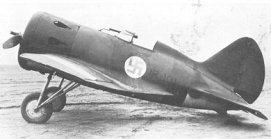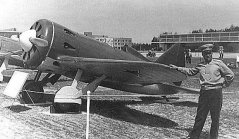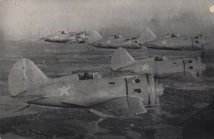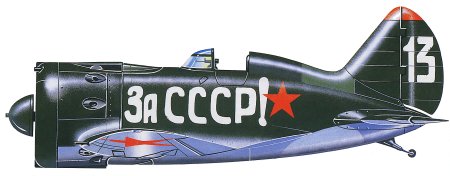
Polikarpov I-16
When Hitler invaded the USSR in 1941, the open-cockpit I-16 was the most numerous fighter in service with the Soviet. Designed to replace biplane fighters, the I-16 was a fast machine when it first appeared in 1934 and was the first low-wing cantilever monoplane with a retractable undercarriage. It is best remembered for fighting with government forces in Spain and China against desperate odds and facing the invasion of the USSR.
Polikarpov began planning a successor to the biplane I-15 series while he was in a Soviet labor camp. In 1933, he designed a rival monoplane to the ANT-31 and the result was the I-16 with its wooden fuselage and metal wing. First prototypes used Soviet M-22 engines, but by 1934 license-built Wright Cyclone engines were fitted, giving a dramatic increase in performance and making the I-16 one of the fastest machines of its day. Although hard to fly, the Soviet forces ordered thousands of them.
The I-16 really made its mark in the Spanish Civil War, where government forces pitted the I-16 against the Fascists. The I-16 was built under license there by Hispano-Suiza. In China, Soviet I-16s flew well in overwhelming air battles with Japanese pilots, repeating this again in 1939 in battles on the Manchurian border. Huge numbers of I-16s were destroyed in the invasion of the USSR, but the aircraft remained in serviced until 1943, by which time it was obviously obsolete.
 |
 |
 |
| During the war with Finland, numerous I-16s were captured by the Finns and restored to use against their former owners. This example is a Type 12 with a tabular sight in the windshield. |
Polikarpov's I-16 was something of a compromise design, accepted into service for all its faults in an attempt to match rival designs that outperformed the earlier (biplane) I-15 in Spain. |
Known as "Mukha' (Russian for fly) in Spain the I-16 was the best Goverment fighter aircraft. |
|
Polikarpov I-16 (Technical Specification) |
| Role |
Single-seat interceptor fighter |
| Manufacturer |
Polikarpov |
| Maximum Speed |
489 kmh (304 mph) |
| Ceiling |
8,268 meters (27,125 feet) |
Weight
Empty
Maximum Takeoff |
1,347 kg (2,970 lbs)
1,711 kg (3,773 lbs) |
Dimensions
Wingspan
Length
Height
Wing Area |
9.14 meters (30 ft)
5.79 meters (19 ft)
2.44 meters (8 ft 2)
14.49 square meters (156 sq ft) |
| Engines |
One Shvetsov M-25 air-cooled radial engine which provides 578-kW (775 hp) |
| Armament |
Four 7.62 mm (0.30 cal) Shpital'ny Komaritsky ShKAS machine-guns in upper fuselage
Six RS-82 rocket projectiles
Six Der-31 bomb containers
Two 100 kgs (220 lbs) bombs (I-16P)
Two 20 mm (0.79 in) ShVAK cannon in wings |
Photo Gallery
Click here to submit your photo
| Have A Passion For Aircraft? |
Subscribe to our 14 series FREE newsletter
delivered weekly on World War 2 Aircraft factfile... |
| NB:- We hate spam as much as you do, so your email address will NEVER be shared with or sold to anyone else. That's a Guarantee. |
|
|





